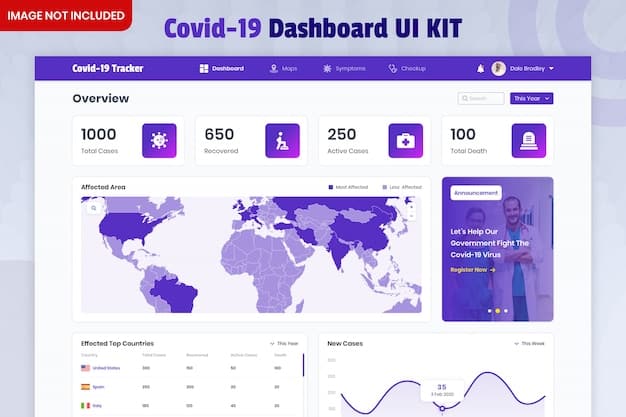AI-Powered Predictive Analytics: Forecasting Disease Outbreaks in the US

AI-powered predictive analytics revolutionizes healthcare in the US by forecasting and managing disease outbreaks through advanced algorithms and data analysis, enabling proactive interventions and resource allocation.
In an era defined by rapid technological advancements, AI-powered predictive analytics is emerging as a vital tool in forecasting and managing disease outbreaks across the United States, offering unprecedented capabilities to anticipate, respond to, and mitigate public health crises.
Understanding AI-Powered Predictive Analytics
AI-powered predictive analytics leverages machine learning algorithms to analyze vast datasets and identify patterns that can forecast future trends, offering a proactive approach to disease outbreak management.
How AI Enhances Predictive Capabilities
AI algorithms can detect subtle anomalies in data that traditional methods might miss, enabling more accurate and timely predictions. This enhanced capability allows healthcare professionals to anticipate outbreaks and implement preventive measures effectively.
- Data Integration: AI integrates diverse data sources, including healthcare records, environmental data, and social media activity, for comprehensive analysis.
- Pattern Recognition: Machine learning algorithms identify complex patterns and correlations that indicate potential outbreaks.
- Real-Time Monitoring: AI systems continuously monitor data streams to provide real-time updates and early warnings.

AI’s ability to process and interpret complex data makes it an indispensable tool for public health officials.
Applications in Forecasting Disease Outbreaks
AI-powered predictive analytics is being applied to forecast a wide range of disease outbreaks, from influenza to vector-borne illnesses, enabling targeted interventions and resource allocation.
Influenza Forecasting
AI models can predict the timing, intensity, and geographic spread of influenza outbreaks, allowing healthcare providers to prepare resources and implement vaccination campaigns effectively.
Vector-Borne Diseases
Predictive analytics can forecast outbreaks of diseases like Zika and West Nile virus by analyzing environmental factors, such as temperature, rainfall, and mosquito populations.
- Environmental Analysis: AI evaluates environmental conditions to predict vector breeding and disease transmission patterns.
- Risk Mapping: Predictive models generate risk maps that identify areas vulnerable to vector-borne diseases.
- Early Warning Systems: AI systems provide early warnings of potential outbreaks, enabling timely interventions.
These applications demonstrate the versatility and potential of AI in safeguarding public health.
Managing Disease Outbreaks with AI
Beyond forecasting, AI plays a crucial role in managing disease outbreaks by optimizing resource allocation, improving surveillance, and enhancing response strategies.
Optimizing Resource Allocation
AI algorithms can analyze data to determine the most effective allocation of resources, such as hospital beds, medical supplies, and personnel, during an outbreak.
Enhancing Surveillance
AI-powered surveillance systems can automatically detect and track disease outbreaks by analyzing data from various sources, including electronic health records, social media, and online news reports.

- Automated Detection: AI systems automatically identify potential outbreaks based on predefined criteria.
- Real-Time Tracking: AI algorithms track the spread of disease in real-time, providing up-to-date information for decision-making.
- Predictive Modeling: AI models forecast the future trajectory of outbreaks, enabling proactive interventions.
By leveraging AI, healthcare organizations can respond more effectively and efficiently to disease outbreaks.
Challenges and Ethical Considerations
Despite the immense potential of AI-powered predictive analytics, several challenges and ethical considerations must be addressed to ensure responsible and effective implementation.
Data Privacy and Security
Protecting patient data is paramount. Robust privacy and security measures are essential to prevent unauthorized access and ensure compliance with regulations like HIPAA.
Bias in Algorithms
AI algorithms can perpetuate and amplify existing biases in data, leading to unfair or discriminatory outcomes. It’s crucial to develop and validate algorithms using diverse and representative datasets.
- Data Diversity: Ensure that datasets used to train AI models are diverse and representative of the population.
- Bias Detection: Implement methods to detect and mitigate bias in algorithms.
- Transparency: Promote transparency in AI decision-making processes to build trust and accountability.
Addressing these challenges is critical to realizing the full potential of AI in healthcare.
The Future of AI in Disease Management
The future of AI in disease management holds immense promise, with ongoing advancements in machine learning, data analytics, and healthcare technology paving the way for more sophisticated and effective solutions.
Personalized Medicine
AI can analyze individual patient data to predict their risk of developing specific diseases and tailor preventive interventions accordingly, leading to more personalized and effective healthcare.
Predictive Modeling for Pandemics
AI-powered models can simulate the spread of infectious diseases and evaluate the impact of different intervention strategies, helping policymakers prepare for and respond to future pandemics.
These advancements underscore the transformative potential of AI in revolutionizing healthcare and improving public health outcomes.
Case Studies: Successful AI Implementations
Several successful implementations of AI-powered predictive analytics demonstrate the tangible benefits of this technology in managing disease outbreaks in the US.
Predicting Flu Trends in California
The California Department of Public Health implemented an AI-powered system that accurately predicts flu trends, enabling targeted vaccination campaigns and resource allocation.
Managing Zika Outbreaks in Florida
Florida’s health authorities utilized AI to analyze environmental data and predict areas at high risk for Zika outbreaks, allowing for proactive mosquito control measures.
| Key Point | Brief Description |
|---|---|
| 🎯 AI Forecasting | Predicts disease outbreaks using machine learning. |
| 🏥 Resource Allocation | Optimizes distribution of medical resources during crises. |
| 🛡️ Surveillance Systems | Monitors and tracks disease spread in real-time. |
| 🔒 Ethical Considerations | Addresses data privacy and algorithm bias to ensure fair use. |
Frequently Asked Questions
▼
AI predictions can be highly accurate, but their accuracy depends on the quality and diversity of the data used to train the models. Ongoing monitoring and validation are crucial.
▼
AI models use a variety of data, including healthcare records, environmental data, social media activity, and demographic information, to forecast disease outbreaks effectively.
▼
Patient privacy is protected through strict data security measures, anonymization techniques, and compliance with regulations like HIPAA to ensure confidentiality and security.
▼
Ethical considerations include addressing bias in algorithms, ensuring transparency in decision-making, and protecting patient privacy to promote fairness and accountability.
▼
The future involves personalized medicine approaches, more sophisticated predictive models, and enhanced capabilities to prepare for and respond to pandemics, driven by ongoing advancements.
Conclusion
AI-powered predictive analytics is revolutionizing disease management in the US by providing tools for forecasting, resource allocation, and response strategies. Addressing challenges and ethical considerations is crucial to ensuring responsible and effective implementation.





